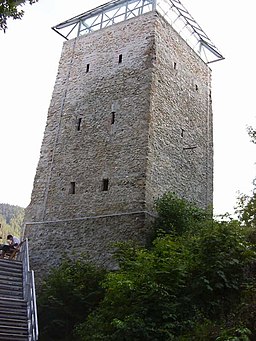Black Tower, Schwarze Turm
Turnul Negru
Black Tower, Schwarze Turm
Turnul Negru
Original function:
town fortification
Current function:
town fortification
Address:
Strada După Ziduri
Historical Hungarian county:
Brassó
GPS coordinates:
45.6412912816, 25.5857015687
History
The town was defended by two towers, the Black and White Towers, which still stand today, on the Warte hill on the north side. The Black Tower is one of the four medieval outer watchtowers of Brassó. It stands on the side of the Raupenberg, close to the Blacksmiths' bastion. It owes its name to the fact that it was struck by lightning in 1559 and was blackened with soot for hundreds of years.
The exact date of its construction is not known, but it was probably built around 1400, together with the first walls of the town fortress. Its purpose was to control the area and repel attackers: without a guard, the enemy could easily approach the town from the Warthe hill and destroy the walls by hurling down rocks. In addition, a 300 kg chain lowered from the tower could be used to close the passage between the rock and the castle wall, bypassing the town fortress in case of danger and 'to prevent smuggling'.
It was first mentioned in documents in 1541. On 23 July 1559, a lightning strike set it on fire, damaging it, burning the roof and blackening the walls. It was repaired in 1669 but was damaged again by fire in 1689 and a lightning strike in 1696. It was repaired again in the early 18th century. It was last used as a watchtower during the plague epidemic of 1756-1757, when guards were stationed here to quarantine the town. In July 1991, rains caused the southern wall to collapse. It was then controversially stripped of its soot layer and covered with a glass roof during renovation. In the early 2000s, the arms exhibition of the county museum was opened in the tower, but it was closed in 2015 as it was not profitable; the interior of the tower has not been open to the public since.
{"item":"sight","set":{"sightId":2016,"townId":77,"active":1,"name_LO":"Turnul Negru","address":"Strada Dup\u0103 Ziduri","mapdata":"1|715|1875","gps_lat":"45.6412912816","gps_long":"25.5857015687","religion":0,"oldtype":"24","newtype":"24","homepage":"","openinghours":"","muemlekemlink":"https:\/\/www.muemlekem.hu\/hatareset\/Varosi-eroditesrendszer-Brasso-1052","csemadoklink":"https:\/\/lexikon.adatbank.transindex.ro\/muemlek.php?id=272","picture":"\u003Ca title=\u0022Auguste at Hungarian Wikipedia, CC BY-SA 2.5 <https:\/\/creativecommons.org\/licenses\/by-sa\/2.5>, via Wikimedia Commons\u0022 href=\u0022https:\/\/commons.wikimedia.org\/wiki\/File:Fekete-torony_(Brass%C3%B3).jpg\u0022\u003E\u003Cimg width=\u0022256\u0022 alt=\u0022Fekete-torony (Brass\u00f3)\u0022 src=\u0022https:\/\/upload.wikimedia.org\/wikipedia\/commons\/thumb\/d\/d0\/Fekete-torony_%28Brass%C3%B3%29.jpg\/256px-Fekete-torony_%28Brass%C3%B3%29.jpg\u0022\u003E\u003C\/a\u003E","picture_ref":"\u003Ca href=\u0022https:\/\/commons.wikimedia.org\/wiki\/File:Fekete-torony_(Brass%C3%B3).jpg\u0022\u003EAuguste at Hungarian Wikipedia\u003C\/a\u003E, \u003Ca href=\u0022https:\/\/creativecommons.org\/licenses\/by-sa\/2.5\u0022\u003ECC BY-SA 2.5\u003C\/a\u003E, via Wikimedia Commons","name":"Black Tower, Schwarze Turm","note":"","history":"The town was defended by two towers, the Black and White Towers, which still stand today, on the Warte hill on the north side. The Black Tower is one of the four medieval outer watchtowers of Brass\u00f3. It stands on the side of the Raupenberg, close to the Blacksmiths' bastion. It owes its name to the fact that it was struck by lightning in 1559 and was blackened with soot for hundreds of years.@\nThe exact date of its construction is not known, but it was probably built around 1400, together with the first walls of the town fortress. Its purpose was to control the area and repel attackers: without a guard, the enemy could easily approach the town from the Warthe hill and destroy the walls by hurling down rocks. In addition, a 300 kg chain lowered from the tower could be used to close the passage between the rock and the castle wall, bypassing the town fortress in case of danger and 'to prevent smuggling'.@\nIt was first mentioned in documents in 1541. On 23 July 1559, a lightning strike set it on fire, damaging it, burning the roof and blackening the walls. It was repaired in 1669 but was damaged again by fire in 1689 and a lightning strike in 1696. It was repaired again in the early 18th century. It was last used as a watchtower during the plague epidemic of 1756-1757, when guards were stationed here to quarantine the town. In July 1991, rains caused the southern wall to collapse. It was then controversially stripped of its soot layer and covered with a glass roof during renovation. In the early 2000s, the arms exhibition of the county museum was opened in the tower, but it was closed in 2015 as it was not profitable; the interior of the tower has not been open to the public since.\n&\nwikipedia: Fekete torony (Brass\u00f3)|https:\/\/hu.wikipedia.org\/wiki\/Fekete_torony_(Brass%C3%B3)\nwelcometoromania.eu: Brass\u00f3, Fekete torony|https:\/\/www.welcometoromania.eu\/Brasov\/Brasov_Turnul_Negru_m.htm","town":{"townId":77,"name_HU":"Brass\u00f3","name_LO":"Bra\u0219ov","seolink":"brasso-brasov","oldcounty":40,"country":4}},"language":"en","region":"romania","regionid":4,"offer":[],"gallery":false,"album":false}

